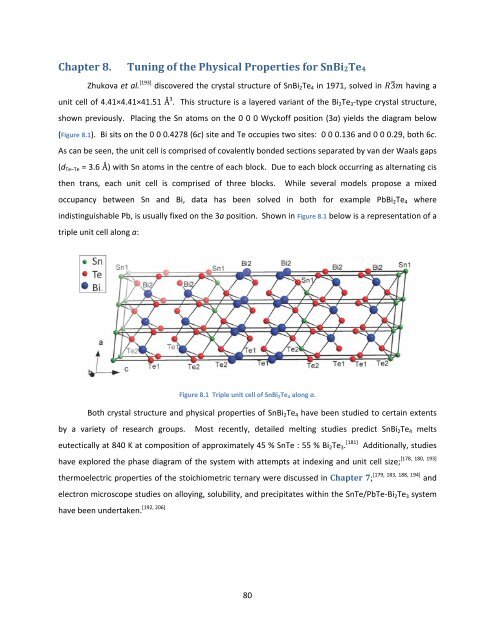Exploration and Optimization of Tellurium‐Based Thermoelectrics
Exploration and Optimization of Tellurium‐Based Thermoelectrics
Exploration and Optimization of Tellurium‐Based Thermoelectrics
You also want an ePaper? Increase the reach of your titles
YUMPU automatically turns print PDFs into web optimized ePapers that Google loves.
Chapter 8. Tuning <strong>of</strong> the Physical Properties for SnBi2Te4<br />
Zhukova et al. [193] discovered the crystal structure <strong>of</strong> SnBi2Te4 in 1971, solved in 3 having a<br />
unit cell <strong>of</strong> 4.41×4.41×41.51 Å 3 . This structure is a layered variant <strong>of</strong> the Bi2Te3‐type crystal structure,<br />
shown previously. Placing the Sn atoms on the 0 0 0 Wyck<strong>of</strong>f position (3a) yields the diagram below<br />
(Figure 8.1). Bi sits on the 0 0 0.4278 (6c) site <strong>and</strong> Te occupies two sites: 0 0 0.136 <strong>and</strong> 0 0 0.29, both 6c.<br />
As can be seen, the unit cell is comprised <strong>of</strong> covalently bonded sections separated by van der Waals gaps<br />
(dTe–Te = 3.6 Å) with Sn atoms in the centre <strong>of</strong> each block. Due to each block occurring as alternating cis<br />
then trans, each unit cell is comprised <strong>of</strong> three blocks. While several models propose a mixed<br />
occupancy between Sn <strong>and</strong> Bi, data has been solved in both for example PbBi2Te4 where<br />
indistinguishable Pb, is usually fixed on the 3a position. Shown in Figure 8.1 below is a representation <strong>of</strong> a<br />
triple unit cell along a:<br />
Figure 8.1 Triple unit cell <strong>of</strong> SnBi2Te4 along a.<br />
Both crystal structure <strong>and</strong> physical properties <strong>of</strong> SnBi2Te4 have been studied to certain extents<br />
by a variety <strong>of</strong> research groups. Most recently, detailed melting studies predict SnBi2Te4 melts<br />
eutectically at 840 K at composition <strong>of</strong> approximately 45 % SnTe : 55 % Bi2Te3. [181] Additionally, studies<br />
[178, 180, 193]<br />
have explored the phase diagram <strong>of</strong> the system with attempts at indexing <strong>and</strong> unit cell size;<br />
thermoelectric properties <strong>of</strong> the stoichiometric ternary were discussed in Chapter 7; [179, 183, 188, 194] <strong>and</strong><br />
electron microscope studies on alloying, solubility, <strong>and</strong> precipitates within the SnTe/PbTe‐Bi2Te3 system<br />
[192, 206]<br />
have been undertaken.<br />
80
















